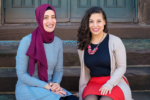When the current school year started a couple of months ago here in Egypt, some students were surprisingly excited about it. For Nada, a 7th grade student, this school year would bring its own surprises, as she was repeatedly asked by the school administration to wear the school uniform “properly” – that is, to wear a headscarf with her uniform. Three weeks later, Nada was prevented from her right to enter class. Lamya Lotfy, Nada’s mother, told MMW by phone that the school sociologist had called her to ask for a meeting with the administration about her daughter’s improper outfit.
“I asked what she meant by “improper uniform,” Lotfy said, “but the sociologist would not give me any details, other than telling me to come and see the school headmistress about my daughter’s uniform. When her father went there and was told the lack of head cover was the problem, he asked for a copy of an official document that states that the headscarf is part of the school uniform in the middle school grades in Egypt. The headmistress said we have that diagram hanging on the wall outside my office. So my husband took a picture of it.”
Nada’s father took the situation to the next level and reported the incident to the relevant educational directorate, which in turn, after being pressed by the family’s efforts to gather media attention, organized for an investigative committee to visit the school and interview both the school administration and its students. The investigation led the school to retract its decision to prevent Nada from entering her class without the headscarf. Now Nada along with four Christian students are the only female students without headscarves in the whole school.
Another, much more complicated case is that of Rahma, the 8th grade student who goes to a school in urban Egypt. According to Rahma’s mother, the school forces even Christian students to wear the headscarf. What made Rahma’s case more complicated was the fact that Rahma’s mother is also a teacher in this school, so she was scared for her employment situation as well as uncertain about the legalities the situation.
According to Lotfy, who also works for the New Woman Foundation, four other mothers reported that their daughter are being forced to wear headscarves to schools.
“What was more painful and offensive,” Lotfy said, “was how upfront the school headmistress was about how all it was all just a fraud. That she was totally fine with telling me and my girl that that was not a hijab, and it would have been totally fine if Nada was to take it off after school. She wanted my kid,” Lotfy emotionally continues, “my growing teenager who goes to school to learn about life, to actually be OK with wearing the scarf just for school and taking it off the minute she gets out of the gate! And then what? Learns to tuck her skirt in to make shorter than she agreed with me? And wear make-up seconds after she gets out of the house?”
As Lotfy suggests, the pervasive hypocrisy when it comes to women, religion, and clothes is quite clear when you look at hijab generally and young girls’ hijab specifically. I myself attended one of the so-called Islamic schools in Cairo, a private school in one of Cairo’s prestigious neighbourhoods where the aspiring upper middle class put their kids to pave the way for the new generation of Muslims. In that school, I was punished publicly for missing prayers, shamed publicly for misreading Qur’an, and mocked repeatedly for my attempts at wearing the hijab, between not wearing it and wearing a “bad hijab”. I was once called off the morning queue to be pointed at by the school headmistress as an example of bad hijab.
Now no one can claim that hijab was forced on me or any other primary students, but every manipulative tool in the book was used to force me to wear it. From honoring students who wear it for the first time, to looking funny at my hair, to indirectly pointing out that my hair didn’t even look that good so it was better for to cover it. I was bullied and mocked by students, teachers, and even Shaikhs for my “behavior”. Luckily for me, I left that school after one year, the year that I scored the least in my whole honorable-degrees education.
While Nada’s case was finally remedied and she was able to continue going to school dressed in her school uniform without hijab, many cases of forced hijab are not taken up. Girls who don’t wear hijab can face bullying as well as a continuous questioning of their religiousity. Nada herself was once held by the police to have her hands checked for crosses or any signs of Christianity, a if any woman with no hijab is a Christian (and as if it is a very bad thing to be Christian). How many girls would actually have the capacity to fight all that? And how many girls would find their parents to be supportive and capable enough to stand by their side in this fight?
Believe me when I tell you, most girls are not as strong as Nada was facing what she faced for more than a month in school, and now being the only Muslim non-hijabi student. Rahma, for an example, could not do anything because her mother was not aware of her legal rights. Compulsory hijab in schools is just the tip of an iceberg of all the societal problems women in Egypt face everyday. Many of these problems have their root in the idea that how a woman looks matters more than anything, that what she wears is a public topic for hundreds of people to talk about, that what society thinks is much more important that what she herself thinks or feels, and that as long as it pleases the general society, it doesn’t have to please God!



